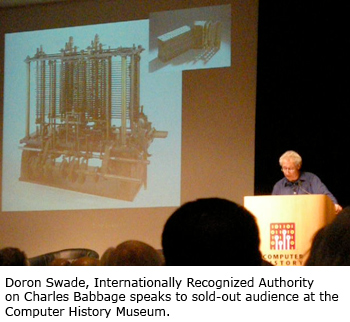Simplicity Makes the Difference: Charles Babbage at Computer History Museum
 ValleyZen covered the Computer History Museum’s sold-out lecture kicking off the “Exhibit Launch of Charles Babbage’s Difference Engine No.2″ by Dr. Doron Swade, the world’s expert on Charles Babbage and by Dr. Nathan Myhrvold, former CTO, Microsoft, founder of Dynamical Systems and co-founder of Intellectual Ventures. Dr. Swade has a unique perspective, because he successfully undertook an experiment completed in 1991 to determine whether Babbage in the period 1847 to 1849 could have built the Difference Engine No. 2. The experiment required Dr. Swade to use 19th Century tools, part designs, and drawings prepared by or available to Babbage at the time the British government withdrew its financial support for Babbage’s work on Engine No. 2. In 1871 Babbage died broke and broken.
ValleyZen covered the Computer History Museum’s sold-out lecture kicking off the “Exhibit Launch of Charles Babbage’s Difference Engine No.2″ by Dr. Doron Swade, the world’s expert on Charles Babbage and by Dr. Nathan Myhrvold, former CTO, Microsoft, founder of Dynamical Systems and co-founder of Intellectual Ventures. Dr. Swade has a unique perspective, because he successfully undertook an experiment completed in 1991 to determine whether Babbage in the period 1847 to 1849 could have built the Difference Engine No. 2. The experiment required Dr. Swade to use 19th Century tools, part designs, and drawings prepared by or available to Babbage at the time the British government withdrew its financial support for Babbage’s work on Engine No. 2. In 1871 Babbage died broke and broken.
The Computer History Museum helped arrange a ValleyZen interview with Dr. Swade after the lecture. Check out the video here. Swade talks about the role of simplicity and negative space in Babbage’s work.
View the Flickr PHOTOS of the event here.
Dr. Swade, who for 14 years was Senior Curator of Computing and IT and Acting Assistant Director, National Museum of Science & Industry [London], centered this lecture on an excellent synopsis of his book The Cogwheel Brain: Charles Babbage and the Quest to Build the First Computer. He described his own experiment and provided numerous facts and remarkable insights regarding Babbage. By the early 19th century the steam engine had mechanized physical labor. However, machines that could perform mental labor were non-existent. Swade told the audience that his book tells the story of Charles Babbage’s Difference Engine No. 2 and how Babbage believed he could build an engine that could perform mental labor.
In addition to building the first Engine No. 2 which permanently resides in the Computing Gallery of the Science Museum in London, Dr. Myhrvold in 2000 commissioned Swade to undertake the building of a second Engine No. 2. The Commission required that the second Engine No. 2 would reside for one year in the Computer History Museum in Mountain View, CA. Thereafter, it would reside in the living room of Dr. Myhrvold.
Drs. Swade and Myhrvold, in their recent lecture at the Computer History Museum shared a hilarious story of how the arrangement was made by Messrs. Myhrvold, Swade and the representatives of the Computer Museum. This resulted in the Mountain View exhibition and the piece for Dr. Myhrvold’s living room (as a companion for a full-size dinosaur). Fielding a question from the audience about the “weirdest” thing in his living room, Dr. Myhrvold promptly responded “Me.” Besides the humor, the lectures were an excellent introduction to the history of computing and Charles Babbage.
The exhibit is currently on view at the Computer History Museum in Mountain View, CA until 2009.

Bill Fenwick & Drue Kataoka



After seeing this post, I wanted to find more about Babbage: Thank you.
An intriguing person. Babbage even tried walking on water.
Read more here:
http://ei.cs.vt.edu/~history/Babbage.html